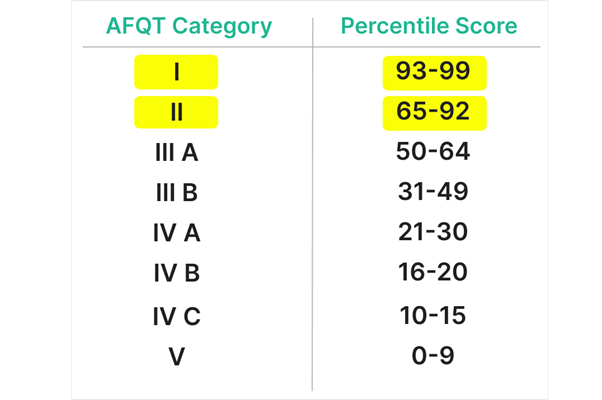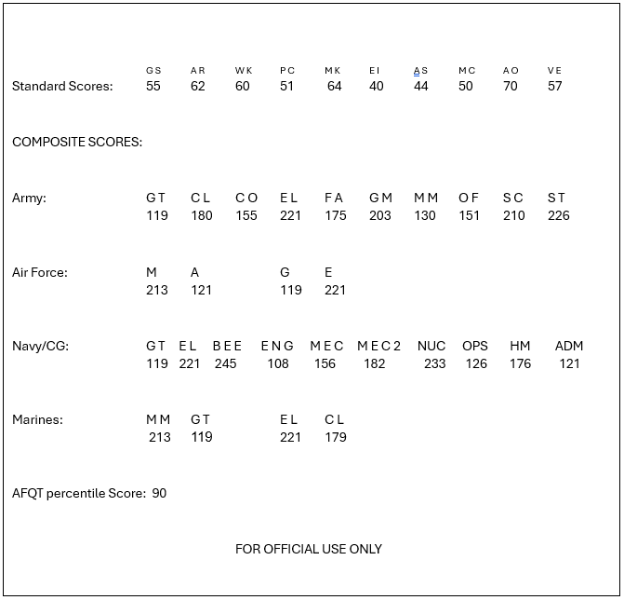 The PiCAT Scores Explained — Optimize Your Results [2025]
The PiCAT Scores Explained — Optimize Your Results [2025]
When preparing to take the PiCAT test, understanding how the scoring system works is vital. The difference between an okay score and achieving your desired military role is knowing which segments are of higher importance and how they are considered. To ensure you know this test from the inside out, we collected all the essential details about the PiCAT scores.
Looking for free PiCAT practice?
What Are the PiCAT Test Scores?
There are 9 sections in the PiCAT test, which are divided into 2 areas:
- The Armed Forces Qualification Test (AFQT) score determines whether you are qualified to serve in the military.
- The Line (Composite) Scores determine your fit for specific army role lines, such as combat, maintenance or technical.
Each part of the scoring has a massive impact on your future military service, and here’s how:
The Armed Forces Qualification Test (AFQT) Scores
Your AFQT score is composed of 4 PiCAT sections:
1. Word Knowledge
2. Paragraph Comprehension
3. Mathematical Knowledge
4. Arithmetic Reasoning
Your score on the AFQT is relative to the percentage of candidates you outperformed. For example, a score of 75 means your score is better than 75% of recruits who took the test. Each military branch has a minimal AFQT score required for enlisting.
The following is the basic PiCAT score chart. Note that the minimum score guidelines consider your previous education as well:
| Military Branch | Army | Navy | Marine Corps | Air Force | Coast Guard |
| Minimum score for high school graduates | 31 | 35 | 32 | 36 | 40 |
| Minimal score for GED diploma | 31 | 50 | 50 | 65 | 50 |
Also, be aware that scoring too low on these sections will invalidate your test, and you will not be able to continue, so make sure you practice correctly.
The following table illustrates the PiCAT score ranges:

Understanding Composite Scores
Along with the overall AFQT score, different combinations of the PiCAT sections scores determine how well you qualify for specific role lines. These are referred to as the Military Occupational Specialties (MOS). Let’s look at different role lines and the subjects that are considered:
| Role Lines | Subjects Required |
| CL — Clerical | Arithmetic Reasoning + Mathematics Knowledge + Verbal Expression |
| CO — Combat | Auto Shop + Mathematics Knowledge + Mechanical Comprehension |
| EL — Electronics | Arithmetic Reasoning + General Science + Electronics Information + Mathematics Knowledge |
| FA — Field Artillery | Arithmetic Reasoning + Mathematics Knowledge + Mechanical Comprehension |
| GM — General Maintenance | Auto Shop + General Science + Electronics Information + Mathematics Knowledge |
| MM — Mechanical Maintenance | Auto Shop + Electronics Information + Mechanical Comprehension |
| OF — Operators and Food | Auto Shop + Mechanical Comprehension + Verbal Expression |
| SC — Surveillance and Communications | Arithmetic Reasoning + Auto Shop + Mechanical Comprehension + Verbal Expression |
| ST — Skilled Technical | General Science + Mechanical Comprehension + Mathematics Knowledge + Verbal Expression |
| GT — General Technical | Arithmetic Reasoning + Verbal Expression |
The best way to really understand these different PiCAT sections is to practice with true-to-life free test questions straight out of our expertly made All-Inclusive ASVAB PrepPack, which is also appropriate for the PiCAT.
By knowing which question categories are relevant for each role group, you can understand how the military will evaluate your potential in your area of interest. Match your studying methods to your desired role.
The PiCAT Score Report
When you finish the PiCAT exam, you get a detailed score report. This is how it will look:

The standard scores represent how well you did in each section.
The composite scores segment illustrates your aptitude in different role lines under each military branch.
The AFQT percentile score reflects your service qualification score.
Create Your Own Assessment Prep Kit!
Finding a job can be a lengthy and challenging journey, often stretching over months and requiring multiple pre-employment tests and interviews. With our Premium Membership, you'll have the support you need every step of the way.
Mix & match 3 Preparation Packs at 50% discount for 1,3, or 6 months
PiCAT Verification Test Passing Score
The verification test does not have a specific passing score. If you passed the PiCAT exam and now face the verification test, you are expected to answer with the same answers you initially chose. Deviating too much from your original answers, even for the better, may fail your verification test and lead you to take the full ASVAB.
Maximizing Your PiCAT Test Scores
Now that we have the PiCAT scores explained, it is up to you to make the best use of your knowledge and practice accordingly. Read more about the PiCAT for tips and strategies on how to score the highest, and try solving free ASVAB, ASVAB line scores and PiCAT practice tests.
Your Scores Will Determine Your Army Journey.
If you are looking to make the best of it, don’t wait for booth camp to outshine. Our PiCAT/ASVAB 3-step formula will get you as far as it goes:
- Take a FULL introduction test to understand your strengths and weaknesses better.
- Extensively practice your weaker test sections using 1000+ questions and simulations.
- Top it all with ASVAB and AFQT simulations to ensure you are all set, or continue practicing.
PiCAT Scores FAQ
Do the ASVAB and the PiCAT Tests Have Different Scoring Systems?
The answer is no. The ASVAB test evaluates the same categories as the PiCAT. Upon successfully finishing the PiCAT verification test, your PiCAT score becomes your official ASVAB score.
What Is the Average PiCAT Score?
As the test score is relative to the percentage of test-takers you passed, 50 is the average score and an excellent goal to achieve. The same goes for the ASVAB scores, as the scoring systems are similar.
What Is a Good PiCAT Score?
Each branch of the US military has its own qualification standards, so it is complex to answer. Minimum passing scores range from 31 to 40, depending on the branch, and aiming for 50 is a wise move if you want to be on the safe side. The bottom line is to figure out which categories are included in your role line of choice and practice efficiently to score the highest you can.
Related Links
ASVAB Scores | ASVAB Practice Test | ASVAB Waiver | Air Force ASVAB Prep | Air Force ASVAB Score | Air Force Cybersecurity | Navy ASVAB Practice Test | OAR Test Prep | PiCAT Practice | Army PiCAT Prep | AFOTQ Practice | EDPT Test | EDPT Practice Test | U.S. Army Recruitment Process | Civil Service Practice Test | Police Practice Test



